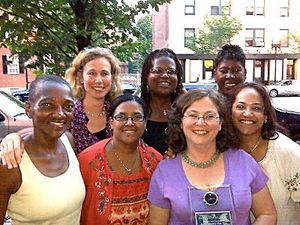A Medical Training Model Addresses Race, Ethnicity, and Culture
Each day, across this country, thousands of medical professionals provide vital medical services to people in acute need. These patients come from all walks of life, all cultures, races, ethnicities, economic and psychosocial circumstances. Very often the medical professionals providing these crucial services come from different backgrounds entirely. Yet in order to provide the medical care so desperately needed by our country’s diverse populations, it is essential that these differences are bridged humanely, compassionately and respectfully.
In 2000, after a frustrated intern confided his negative attitude towards the patients he was treating, a medical educator assembled a diverse group of dedicated physician colleagues at the former Boston City Hospital who seemed to feel much more effective and indeed found their patients inspiring.

To improve medical training and reduce health care disparities, this group of clinician-educators at Boston Medical Center and Boston University School of Medicine developed the RESPECT model. The model teaches physicians to communicate more effectively—especially when there are differences of race, class or culture, and is featured in the current Special Issue on Healthcare Disparities Education in the Journal of General Internal Medicine. According to the authors this model not only provides a framework for what to do—it also shows preceptors how to teach this skill set to medical trainees. Their article describes the ways they have used the model in training various levels of learners in a number of settings and includes specific teaching tools.
RESPECT stands for specific behaviors needed for patient interactions such as:
Respect: Show respect by attentive listening, eye contact and posture. Recognize patients’ choices and accomplishments.
Explanatory model: Ask what the patient thinks caused his or her illness and what he or she believes will help treat it.
Social context: Find out how the patient’s life affects his or her illness; include stressors, supports and spirituality.
Power: Share power by listening to the patient and asking for his or her preferences in treatment.
Empathy: Show empathy by verbally and non-verbally responding to patients’ emotions and concerns and demonstrating understanding of their significance.
Concerns: Ask the patient, “What worries you the most?” or “What concerns should I know about?”
Trust/ Therapeutic alliance: Build trust and find common ground. Make sure that the patient is comfortable with the treatment plan or collaborate to find a mutually agreeable alternative.
As a relational guide applied to teaching, the RESPECT model can also build trust in the preceptor/trainee relationship. “Respectful communication across power differentials between faculty, residents and colleagues promotes positive professional communication and teamwork along with full and open disclosure of what the real challenges are,” says Carol Mostow, LICSW, Associate Director, Psychosocial Training in the department of Family Medicine at Boston Medical Center and lead author of the article. “Unfortunately, the rigorous clinical training process of medical school and residency that produces knowledgeable and medically skilled doctors has been associated nationally with an erosion of empathy and other interpersonal skills needed for effective patient care. Using RESPECT in our interactions with learners and colleagues can change that culture to restore empathy with each other and our patients, promoting a personal and systems-based examination of obstacles to optimum care and patient safety, especially important for patients at risk for poor outcomes.”
The article co-authors are:
- Julie Crosson, MD, Dorchester House, Section of General Internal Medicine, Boston Medical Center; Boston University School of Medicine
- Sandra Gordon, MD, Department of Medicine, Section of General Internal Medicine, Boston Medical Center; Boston University School of Medicine
- Sheila Chapman, MD, Department of Medicine, Section of General Internal Medicine, Boston Medical Center; Boston University School of Medicine
- Eric Hardt, MD Department of Medicine, Section of Geriatrics, Boston Medical Center; Boston University School of Medicine
- Peter Gonzalez MD, Department of Medicine, Beth Israel-Deaconess Medical Center, Harvard Medical School
- Leyda Delgado, MD, Department of Medicine, Section of General Internal Medicine; Boston Medical Center Latino Clinic; Boston University School of Medicine
- Thea James, MD, Department of Emergency Medicine, Boston Medical Center; Boston University School of Medicine
- Michele David MD, MPH, MBA Department of Medicine, Section of General Internal Medicine, Boston Medical Center; Boston University Center for Excellence in Women’s Health; Haitian Health Institute at Boston Medical Center; Boston University School of Medicine.
View the complete article here